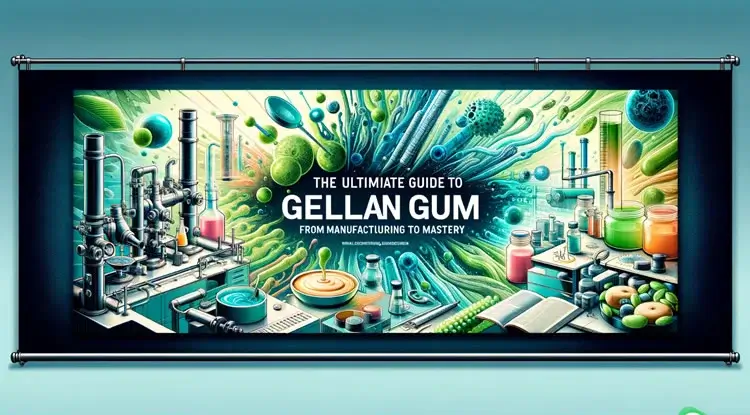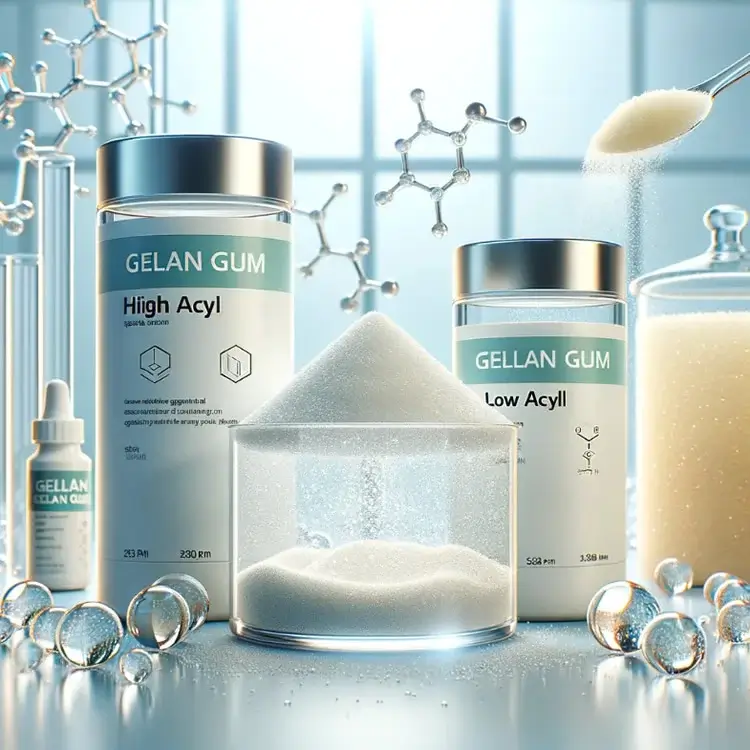Are you struggling to unlock the full potential of Gellan Gum in your product formulations? Are the complexities of manufacturing and mastering this versatile ingredient leaving you perplexed? If so, fret not! You’re not alone in facing these challenges. In today’s competitive market, finding the right Gellan Gum manufacturer can be overwhelming. But fear not! In this comprehensive guide tailored for Gellan Gum manufacturers, we’ll delve deep into the intricacies of this ingredient, offering expert insights and actionable strategies to help you overcome hurdles and achieve success. From understanding the manufacturing process to optimizing its applications, we’ve got you covered every step of the way.

Gellan Gum holds tremendous promise for enhancing the quality, texture, and stability of a wide range of products. However, navigating its complexities and harnessing its full potential can be overwhelming for manufacturers and formulators alike. In the following sections, we’ll explore key aspects of Gellan Gum, including manufacturing processes, selection criteria, application strategies, and future trends. By the end of this guide, you’ll have the knowledge and confidence to elevate your products to new heights with Gellan Gum mastery.
The Ultimate Guide to Gellan Gum: From Manufacturing to Mastery

Introduction
Welcome to the ultimate guide to Gellan Gum, where we explore everything from its manufacturing process to mastering its applications. Gellan Gum, a versatile polysaccharide, has become an indispensable ingredient in various industries. In this comprehensive guide, we delve deep into understanding Gellan Gum, choosing the right manufacturer, purchasing considerations, product showcase, implementation best practices, and the future of this remarkable ingredient.
Understanding Gellan Gum: A Brief Overview
Gellan Gum is a polysaccharide produced by the bacterium Sphingomonas elodea. It possesses unique gelling properties, making it a valuable additive in food, pharmaceutical, and cosmetic products. Its versatility, stability, and compatibility with other ingredients have contributed to its widespread use across industries.
The Importance of Choosing the Right Manufacturer
Selecting a reputable Gellan Gum manufacturer is crucial for ensuring product quality, consistency, and compliance with regulatory standards. Manufacturers play a pivotal role in determining the reliability and performance of Gellan Gum-based products.
Section 1: Gellan Gum Manufacturers Overview
The Global Landscape of Gellan Gum Production
Gellan Gum production is distributed worldwide, with key manufacturing hubs in regions such as Asia, Europe, and North America. Each region offers unique advantages in terms of raw material accessibility, production infrastructure, and market reach.
Key Players in the Market
Several prominent manufacturers dominate the Gellan Gum market, offering a diverse range of products tailored to different industry requirements. Leading manufacturers prioritize innovation, quality control, and customer satisfaction to maintain their competitive edge.
Geographic Manufacturing Hotspots
Certain regions, such as China and the United States, are renowned for their extensive Gellan Gum production capabilities. These geographic hotspots benefit from favorable climatic conditions, abundant resources, and established manufacturing infrastructure.
The Manufacturing Process of Gellan Gum
Gellan Gum manufacturing involves a series of precise steps, from sourcing raw materials to final product packaging. The process typically includes fermentation, purification, drying, and quality testing to ensure compliance with industry standards.

Raw Materials and Sources
Gellan Gum production relies on renewable resources such as carbohydrates derived from plants or microbial fermentation. Common raw material sources include glucose, sucrose, and industrial-grade microorganisms.
Step-by-Step Production Process
- Fermentation: Microorganisms such as Sphingomonas elodea are cultured in a nutrient-rich medium to produce Gellan Gum.
- Purification: The fermented broth undergoes filtration and purification to remove impurities and microbial cells.
- Drying: The purified Gellan Gum solution is dried to form a powdered or granular product suitable for storage and transportation.
- Quality Control and Certification: Stringent quality control measures are implemented throughout the manufacturing process to ensure product purity, consistency, and compliance with regulatory requirements.
Standards and Regulations
Gellan Gum manufacturers adhere to industry standards and regulations, including food safety guidelines, quality management systems, and environmental sustainability practices. Certifications such as Kosher, Halal, and Organic demonstrate a manufacturer’s commitment to meeting diverse consumer preferences and requirements.
Section 2: How to Choose a Gellan Gum Manufacturer
Selecting the right Gellan Gum manufacturer requires careful consideration of various factors, including quality assurance practices, supply chain reliability, cost-effectiveness, and geographical proximity.
Factors to Consider When Selecting a Manufacturer
- Quality Assurance Practices: Evaluate the manufacturer’s quality control procedures, testing protocols, and adherence to international standards such as ISO and HACCP.
- Supply Chain Reliability: Assess the manufacturer’s supply chain capabilities, including raw material sourcing, production capacity, and distribution network.
- Cost-Effectiveness: Balance product quality with cost considerations to ensure optimal value for your investment.
- Understanding the Value of Local vs. International Manufacturers: Compare the advantages and disadvantages of sourcing Gellan Gum from local suppliers versus international manufacturers.
Pros and Cons of Each
- Local Manufacturers:
- Pros: Greater accessibility, shorter lead times, potential for closer collaboration and support.
- Cons: Limited production capacity, higher costs in some cases, dependency on local market dynamics.
- International Manufacturers:
- Pros: Expanded product range, competitive pricing, access to advanced technology and expertise.
- Cons: Longer lead times, language and communication barriers, potential logistical challenges.
Import Regulations and Impact on Cost
Consider the impact of import regulations, tariffs, and trade agreements on the cost and availability of Gellan Gum from international manufacturers. Engage with customs brokers and legal experts to navigate regulatory requirements effectively.
Section 3: Purchasing Guide for Gellan Gum
Navigating the purchasing process for Gellan Gum requires careful planning and consideration of various sourcing options, negotiation strategies, and contract terms.
How to Buy Gellan Gum: A Comprehensive Guide
Explore different procurement channels, including direct purchases from manufacturers, distributor partnerships, and online marketplaces. Evaluate the pros and cons of each option based on factors such as pricing, product availability, and service level agreements.
Direct from Manufacturers vs. Distributors
- Direct Purchases: Directly sourcing Gellan Gum from manufacturers offers greater control over product specifications, quality assurance, and customization options.
- Distributor Partnerships: Working with authorized distributors provides access to a broader product portfolio, logistical support, and localized customer service.
Online Marketplaces and B2B Platforms
Utilize online platforms and business-to-business (B2B) marketplaces to discover new suppliers, compare pricing and product offerings, and streamline the purchasing process. Exercise caution when engaging with unfamiliar vendors and prioritize reputable sellers with positive reviews and ratings.
Negotiating Prices and Contracts
Negotiate pricing agreements and contract terms with manufacturers or distributors to secure favorable terms and conditions. Consider factors such as volume discounts, payment terms, delivery schedules, and warranty provisions when finalizing purchase agreements.
Tips for Getting the Best Deal
- Conduct Market Research: Compare prices from multiple suppliers to identify competitive offers and negotiate from a position of knowledge.
- Build Relationships: Cultivate long-term partnerships with reliable suppliers by demonstrating loyalty, transparency, and mutual respect.
- Flexibility and Adaptability: Remain open to alternative solutions, such as bulk purchasing, consignment arrangements, or cooperative sourcing initiatives, to optimize cost savings and supply chain efficiency.
Understanding Contract Terms
Review contract terms and conditions carefully to clarify rights, responsibilities, and dispute resolution mechanisms. Seek legal counsel or contract management expertise to ensure compliance with relevant laws and regulations and mitigate potential risks.
Section 4: Product Showcase – Features and Advantages
Explore the diverse range of Gellan Gum products available in the market, highlighting their unique features, applications, and benefits.
Types of Gellan Gum and Their Applications
Gellan Gum is available in two primary forms: High Acyl and Low Acyl, each with distinct properties and applications.
- High Acyl Gellan Gum: Exhibits excellent gel strength, elasticity, and stability, making it suitable for a wide range of food and beverage applications, including dairy, desserts, and sauces.
- Low Acyl Gellan Gum: Provides superior heat stability, clarity, and texture control, making it ideal for use in pharmaceutical formulations, personal care products, and plant-based alternatives.
Industry-Specific Uses: Food, Pharmaceutical, and Others
Gellan Gum finds applications across various industries, including:
- Food and Beverage: Thickening, gelling, and stabilizing agent in dairy products, fruit juices, confectionery, and sauces.
- Pharmaceuticals: Controlled release formulations, suspensions, and oral dosage forms in pharmaceutical and nutraceutical products.
- Cosmetics and Personal Care: Emulsions, gels, and creams in skincare, haircare, and oral care formulations.
- Industrial Applications: Microbial culture media, oil drilling fluids, and textile printing thickeners in industrial processes.
Comparative Analysis: Gellan Gum vs. Other Gelling Agents
Compare Gellan Gum with alternative gelling agents, including Agar-Agar, Gelatin, and Carrageenan, based on performance, cost, and application differences.
Introduction
In the realm of food and pharmaceutical industries, the choice of gelling agents plays a critical role in achieving desired textures, stability, and sensory attributes in products. Gellan Gum stands out as a popular choice, but how does it compare to other gelling agents? Let’s delve into a comparative analysis to understand the strengths and weaknesses of Gellan Gum in comparison to agar-agar, gelatin, and carrageenan.
Gellan Gum
Key Features:
- Derived from microbial fermentation, Gellan Gum offers excellent gel strength and stability.
- Provides versatile functionality, including gelling, thickening, and stabilizing properties.
- Exhibits heat stability, clarity, and shear-thinning behavior, making it suitable for a wide range of applications.
Agar-Agar
Key Features:
- Derived from seaweed, agar-agar offers strong gelling properties and is commonly used in food and microbiological applications.
- Provides a firm and brittle gel texture, making it suitable for solidifying culture media and desserts.
- Requires high temperatures for hydration and gelling, limiting its application in heat-sensitive formulations.
Gelatin
Key Features:
- Derived from animal collagen, gelatin offers excellent gel strength, elasticity, and clarity.
- Widely used in food, pharmaceuticals, and cosmetics for its gelling, thickening, and stabilizing properties.
- Sensitive to temperature fluctuations and pH levels, requiring careful formulation adjustments.
Carrageenan
Key Features:
- Extracted from seaweed, carrageenan offers strong gelling properties and viscosity control.
- Comes in various forms, including kappa, iota, and lambda, each with distinct gel textures and applications.
- Known for its ability to form elastic and thermally reversible gels, making it suitable for dairy and meat products.
Comparative Analysis
Texture and Consistency:
- Gellan Gum offers a wide range of textures, from firm and brittle to soft and elastic, depending on formulation parameters.
- Agar-agar provides a firm and brittle gel texture, while gelatin offers a soft and elastic texture.
- Carrageenan forms elastic and thermally reversible gels, contributing to the desired mouthfeel in dairy and meat products.
Heat Stability:
- Gellan Gum exhibits excellent heat stability, making it suitable for hot-fill and pasteurized products.
- Agar-agar requires high temperatures for hydration and gelling, limiting its application in heat-sensitive formulations.
- Gelatin may lose its gel strength at elevated temperatures, affecting the stability of formulations.
Compatibility with Ingredients:
- Gellan Gum shows good compatibility with a wide range of ingredients, including acids, salts, and sugars.
- Agar-agar may interact with certain ingredients, affecting gelation and texture.
- Gelatin may require specific pH conditions for gel formation, limiting its compatibility with acidic formulations.
Conclusion
While Gellan Gum offers numerous advantages such as versatility, stability, and compatibility, it’s essential to consider the specific requirements and characteristics of each gelling agent when formulating products. By understanding the comparative analysis between Gellan Gum and other gelling agents, manufacturers can make informed decisions to optimize formulations and achieve desired product attributes.
The Sustainability of Gellan Gum
Assess the environmental impact and sustainability credentials of Gellan Gum compared to traditional gelling agents.
- Environmental Impact: Gellan Gum production requires less land, water, and energy compared to animal-derived gelling agents, contributing to lower environmental footprint and resource conservation.
- Biodegradability and Vegan Status: Gellan Gum is biodegradable and suitable for vegan and vegetarian lifestyles, aligning with consumer preferences for sustainable and cruelty-free products.
Section 5: Implementation and Best Practices
Discover practical insights and recommendations for incorporating Gellan Gum into product development and overcoming common challenges.
How to Incorporate Gellan Gum in Product Development
Follow formulation guidelines and best practices to optimize the performance and functionality of Gellan Gum in various applications.
- Formulation Guidelines: Determine the appropriate concentration, hydration temperature, and mixing procedures to achieve desired texture, viscosity, and stability.
- Case Studies and Success Stories: Learn from real-world examples of successful Gellan Gum formulations and applications in different industries.
Overcoming Common Challenges
Address solubility issues, compatibility concerns, and synergy with other ingredients to maximize the efficacy and performance of Gellan Gum-based products.
- Solubility Issues: Ensure proper hydration and dispersion of Gellan Gum particles to prevent clumping and achieve uniform gel formation.
- Synergy with Other Ingredients: Experiment with different combinations of ingredients, additives, and processing techniques to enhance the functionality and sensory attributes of Gellan Gum formulations.
Section 6: The Future of Gellan Gum
Explore emerging trends, innovations, and market opportunities shaping the future of Gellan Gum manufacturing and applications.
Emerging Trends and Innovations in Gellan Gum Manufacturing
Stay informed about technological advancements, research breakthroughs, and industry developments driving innovation and product differentiation in the Gellan Gum market.
Novel Applications and Market Growth Predictions
Anticipate the expansion of Gellan Gum applications into new industries and product categories, driven by consumer demand for clean label, plant-based alternatives, and functional ingredients.
The Role of Gellan Gum in Sustainable Manufacturing Practices
Recognize the pivotal role of Gellan Gum in promoting sustainability, resource efficiency, and circular economy principles across the value chain.
Conclusion
In conclusion, Gellan Gum represents a versatile and sustainable solution for enhancing product performance, texture, and stability across diverse industries. By understanding the manufacturing process, choosing the right supplier, and implementing best practices, businesses can harness the full potential of Gellan Gum to drive innovation and market success.
Recap of Key Takeaways
- Gellan Gum is a polysaccharide with unique gelling properties, widely used in food, pharmaceutical, and cosmetic applications.
- Choosing the right manufacturer is essential for ensuring product quality, compliance, and reliability.
- Consider factors such as quality assurance practices, supply chain reliability, and cost-effectiveness when selecting a Gellan Gum manufacturer.
- Navigate the purchasing process effectively by exploring different procurement channels, negotiating prices, and understanding contract terms.
- Explore the diverse range of Gellan Gum products available in the market and their applications across various industries.
- Implement best practices for incorporating Gellan Gum into product formulations and overcoming common challenges.
- Stay informed about emerging trends, innovations, and market opportunities shaping the future of Gellan Gum.
FAQs
What is Gellan Gum and why is it used?
Gellan Gum is a polysaccharide produced by the bacterium Sphingomonas elodea. It is used as a gelling, thickening, and stabilizing agent in food, pharmaceutical, and cosmetic products due to its unique texture, stability, and compatibility with other ingredients.
How do I choose the right Gellan Gum manufacturer?
When selecting a Gellan Gum manufacturer, consider factors such as quality assurance practices, supply chain reliability, cost-effectiveness, and geographical proximity. Evaluate the manufacturer’s certifications, production capabilities, and track record to ensure alignment with your requirements and preferences.
What are the main differences between High Acyl and Low Acyl Gellan Gum?
High Acyl Gellan Gum offers superior gel strength and elasticity, making it suitable for a wide range of food applications. Low Acyl Gellan Gum provides enhanced heat stability and clarity, making it ideal for pharmaceutical and cosmetic formulations requiring transparent gels or suspensions.

Can Gellan Gum be considered a sustainable product?
Yes, Gellan Gum is considered a sustainable product due to its renewable raw materials, efficient production process, and biodegradability. It offers environmental benefits compared to animal-derived gelling agents and synthetic additives, aligning with consumer preferences for eco-friendly and ethical products.
How can businesses effectively negotiate with manufacturers?
Businesses can negotiate effectively with manufacturers by conducting thorough market research, building relationships, and demonstrating flexibility and adaptability. Focus on mutual value creation, transparency, and open communication to establish long-term partnerships and achieve favorable pricing and contract terms.
This comprehensive guide aims to provide actionable insights and practical advice for navigating the complex landscape of Gellan Gum manufacturing, procurement, and utilization. By understanding the fundamentals and staying informed about industry trends, businesses can leverage Gellan Gum to drive innovation, sustainability, and market differentiation.

Unlock the full potential of Gellan Gum with expert insights from SHINE Additives. Watch our informative video on Gellan Gum manufacturing and applications: SHINE Additives on YouTube.
In conclusion, Gellan Gum offers unparalleled opportunities for innovation and excellence in product development. Whether you’re a seasoned manufacturer or a budding formulator, mastering the intricacies of Gellan Gum can unlock new possibilities for your brand. By investing in high-quality Gellan Gum solutions from trusted suppliers like SHINE, you can differentiate your products, delight your customers, and stay ahead of the competition. Don’t let uncertainty hold you back. Embrace the potential of Gellan Gum and take your formulations to the next level today!
Ready to elevate your products with premium Gellan Gum solutions? Visit SHINE now to explore our range of offerings and take the first step towards Gellan Gum mastery.
